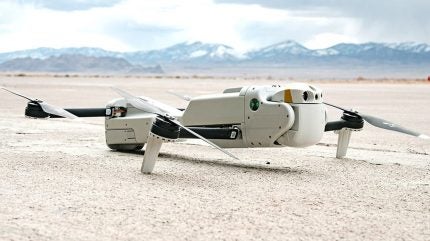
Teledyne FLIR Defense, a player in defence technology, has unveiled the Rogue 1 loitering munition system and showcased its capabilities at the Special Operations Forces (SOF) Week convention in Tampa.
Designed for rapid deployment and adaptability to evolving battlefield scenarios, Rogue 1 offers warfighters versatility and survivability.
Unlike traditional unmanned aerial systems, Rogue 1 features a fuzing system that enables safe drone recovery and reuse. This enhances mission flexibility and minimises resource wastage, providing military forces with a cost-effective solution for dynamic combat environments.
Leveraging sensor technology from Teledyne FLIR, Rogue 1 has electro-optical and thermal cameras, delivering reconnaissance and surveillance capabilities day and night. Its mission-specific payload options, including lethal and non-lethal alternatives, allow operators to engage enemy targets beyond the line of sight.
With a flight time of 30 minutes, burst speeds exceeding 70 mph, and a range of over six miles, Rogue 1 is optimised for the rigours of modern warfare, including GPS-denied environments. Its lightweight design and features make it an asset for ground forces, providing precision and minimising collateral damage.
Dr. JihFen Lei, executive vice president and general manager of Teledyne FLIR Defense, emphasised Rogue 1’s significance in meeting the demands of the contemporary battlespace. “The new Rogue 1 gives warfighters the versatility, survivability and lethality demanded by the modern battlespace,” Lei stated.
“With its unique ability to be recovered and reused when targeting conditions change, this innovative platform also offers military forces greater economy and flexibility.”
Rogue 1’s performance has already garnered acclaim, with the US Marine Corps selecting it for their Organic Precision Fires-Light (OPF-L) programme. Under this contract, Teledyne FLIR Defense will deliver an initial order of 127 systems.
In recent years, Teledyne FLIR Defense has been awarded two contracts by the US Department of Defense (DoD). The first involved expanding the capabilities of the R80D SkyRaider uncrewed aerial system to autonomously conduct chemical, biological, radiological, and nuclear reconnaissance missions, eliminating soldiers’ exposure to toxic substances.
The second contract, worth up to $500.2m, involves delivering thermal imaging systems for the US Army’s Family of Weapons Sights-Individual (FWS-I) programme. These battery-operated systems provide soldiers with infrared imagery in all weather and lighting conditions, aiding target acquisition and minimising exposure to enemy fire.
Teledyne FLIR Defense has also supplied 127 PackBot 525 unmanned ground vehicles (UGVs) to the German Army (Deutsches Heer). These ground robots offer capabilities ranging from bomb disposal and surveillance to hazardous environment operations.








